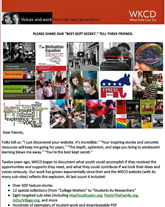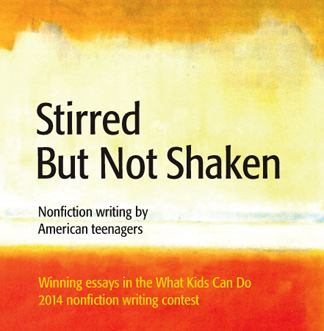OTHER WKCD WEBSITES SPECIAL COLLECTIONS Students as Allies in School POPULAR WKCD PUBLICATIONS (PDFS] A Guide to Creating Teen- Cultural Conversations through Creative Writing Documenting Immigration Stories First Ask, Then Listen: How Your Students Can Help You Teach Them Better Making Writing Essential to Profiles of Politically Active Youth Queer Youth Advice for Educators The Schools We Need: Creating Small High Schools That Work for Us
| Stirred But Not Shaken: Nonfiction writing by American Teenagers by WKCD| AUGUST 28, 2014
PROVIDENCE, RI—In 2006, What Kids Can Do, Inc. (WKCD) and Next Generation Press published a book of nonfiction essays by youth across the country. Called Hip Deep: Opinion, Essays, and Vision from American Teenagers, the book became a favorite with students (and teachers) who appreciated youth writing about issues meaningful to them. Eight years later, the Common Core’s “anchor standards for writing” are shining a fresh light on nonfiction writing by America’s teens. They require students to craft narratives that “develop real or imagined experiences or events using effective technique, well-chosen details, and well-structured event sequences.” They call for proficiency in writing arguments that “support claims in an analysis of substantive topics or texts, using valid reasoning and relevant and sufficient evidence.” They demand that students learn to write informative, explanatory texts that “examine and convey complex ideas and information clearly and accurately through the effective selection, organization, and analysis of content.” This past spring, inspired by these new standards, WKCD invited teenagers nationwide to send us the best nonfiction essay they had written this year (or last) on a topic that they cared about deeply. Winners would win a $100 prize and be included in a WKCD publication. Later, we added a second-place award category with $50 prizes. “We’re looking for diverse voices on diverse topics: family, school, learning, relationships, race, culture, origins, religion, body image, social media, conflict, peace, change, our planet . . . . or whatever topic you choose,” the contest flyer said. “We care most about fresh ideas and stories written in a strong and true voice, in or outside school. We’re listening for what moves our readers and what gives them hope—that’s why we call our contest Stirred but Not Shaken.” Six weeks after our contest announcement, we had received over 200 submissions from a remarkable swath of students, grades 8 - 12: privileged and not; native and foreign born (from 20 countries); rural, suburban, and urban (from 18 states). Whether they attended one of our nation’s elite private schools or a school for incarcerated juveniles, these young people wrote with purpose, determined to find their own voice and their own true north. What did they write about, what stirred them? They wrote about living in two worlds: about hard work and dignity from a mother snared in poverty while mastering calculus in a school dedicated to training young scientists; about returning home to visit relatives in Singapore and finding comfort in an old Turkish perfume shop; about meeting a Korean father’s expectations for perfect grades and defining self-worth on one’s own; about negotiating the stereotypes that stalk young African-American males, hoodie-d or not. Many of these young writers shared stories and secrets about coming of age, their families’ dissolution, struggles with body image and depression, or coping with life-threatening illnesses. They chronicled how they had come to peace with what had been so hard or how they were “rising to a place of light and affirmation,” as one writer called it. Often, it was the pure eloquence of the writing that commanded our attention. Sometimes it was the wry wit. Honesty was a given. Social-emotional learning was the through line. Not surprisingly, both the essays we choose and those we didn’t underscored the power students feel—both as writers and as adolescents—when they have the opportunity to speak form the heart, believing that what they have to say matters and that people are listening. Reading their words, we are reminded how much adolescents want to be noticed and to succeed, to do well by their families, to stand out as individuals—even when it seems they long to be invisible, when they slack in school or “diss” their family, when they seem consumed by fitting in. Let us say a few words more about our selection process. At the same time that we kept an eye on what constitutes strong nonfiction writing—whether defined by today’s Common Core or the famous essayist E.B. White—it was fresh ideas and stories written in a strong voice that topped our rubric. This, you may know, is part of the WKCD tradition. We listened, too, for what would move readers and what would give them hope. We also wanted to reflect and honor the diversity of learners that invigorate our nation’s schools. Not surprisingly, the unequal opportunities that separate our schools also show up in their students’ writing—not just in the tenor of the stories they tell, but in their punctuation, grammar, and sheer polish. For the purpose of clarity, we edited slightly many of the essays you will find here, without sacrificing, we believe, their authenticity. Some of these winning essays, we realize, might not score “proficient” in their mastery of common writing conventions. (Indeed, students and teachers reading this collection might discuss how a particular essay diverges from standard, best practice.) Finally, we ended up creating a special category for informational essays. The tendency to paint with one broad stroke rising generations as “indifferent” has never been fair. Far from being indifferent, the young writers whose persuasive essays we share here are eager to let their passions flow on topics that touch them, on issues they feel need a shout out and a fix: legalizing gay marriage, prosecutorial misconduct, nuclear fission, fast food, pesticides and bees, and more. When we notified winners in our Stirred but Not Shaken contest, one tenth-grader wrote back: “Oh my word! Thank you so, so, so much! I can't express how much this means to me.” The thanks, though, is ours: to the young people who trusted us all with their voices and vision. Barbara Cervone and Kathleen Cushman, co-founders, What Kids Can Do, Inc (WKCD) Providence, Rhode Island, July 2014
What Kids Can Do, Inc. | info@whatkidscando.org | www.whatkidscando.org
|



